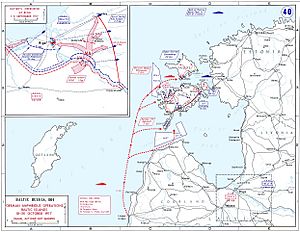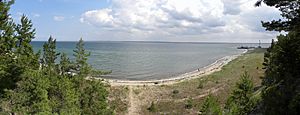Operation Albion facts for kids
Quick facts for kids Operation Albion |
|||||||
|---|---|---|---|---|---|---|---|
| Part of World War I | |||||||
 Operation Albion amphibious operations 12–20 October |
|||||||
|
|||||||
| Belligerents | |||||||
| Commanders and leaders | |||||||
| Strength | |||||||
| 1 battlecruiser 10 dreadnought battleships 9 light cruisers 1 mine cruiser 50 torpedo boats 6 U-boats 19 transports 6 airships 102 combat aircraft 24,500 soldiers 8,500 horses 2,400 vehicles 150 machine guns 54 guns 12 mortars |
2 pre-dreadnought battleships 2 cruisers 1 protected cruiser 21 destroyers 3 gunboats 3 submarines 24,000 soldiers |
||||||
| Casualties and losses | |||||||
| 1 torpedo boat sunk (S 64) 7 minesweepers destroyed 9 trawlers & auxiliary vessels destroyed 5 aircraft shot down 156 killed 60 wounded (Navy) 54 killed 141 wounded (Army) |
1 battleship sunk (Slava) 1 destroyer sunk (Grom) 1 submarine destroyed (HMS C32) Unknown dead and wounded 20,130 captured 141 guns lost (47 heavy guns) 130 machine guns lost 40 aircraft lost |
||||||
Operation Albion was a big military plan by Germany during World War I. It involved their air force, army, and navy. The goal was to take over some islands from Russia in October 1917. These islands were part of the West Estonian Archipelago.
German soldiers landed on Saaremaa island at Tagalaht bay on October 12, 1917. Before this, German ships had to clear away dangerous underwater mines. They also had to silence Russian cannons on the coast. Germany took control of Saaremaa by October 16. Russian soldiers then left Muhu island on October 20.
After trying twice and failing, German forces landed on Hiiumaa island on October 12. They captured it the very next day. The Russian Baltic Fleet had to leave the Suur Strait after losing ships in the Battle of Moon Sound. Germany announced they had captured 20,000 prisoners and 100 cannons during Operation Albion. This happened between October 12 and October 20.
Contents
Why These Islands Mattered
At the start of World War I, these islands were not very important to either Russia or Germany. But things changed in 1917. Russia was going through a lot of political trouble, known as the Russian Revolution.
The German military leaders saw an opportunity. They believed that capturing these islands would help them get around Russian defenses. This would make the Russian capital city, Petrograd (now St. Petersburg), open to attack.
Who Fought in Operation Albion
This operation involved many different types of military units. Both Germany and Russia had large forces. The United Kingdom also had some submarines helping Russia.
German Forces
Germany used a powerful naval fleet for Operation Albion. Vice Admiral Ehrhard Schmidt led these naval forces.
- Warships: Germany had a battlecruiser, ten large battleships, and nine light cruisers. They also had a mine cruiser and many torpedo boats.
- Submarines: Six German submarines were part of the operation.
- Air Power: Six airships and over 100 combat aircraft supported the attack.
- Troops: About 24,500 German soldiers took part. They also brought thousands of horses and vehicles. They had many machine guns, cannons, and mortars.
Russian Forces
Russia defended the islands with both land and naval forces.
- Soldiers: About 24,000 Russian soldiers were on the islands.
- Warships: The Russian navy had two older battleships and three cruisers. They also had many destroyers and some gunboats.
- Submarines: Three Russian submarines were involved.
British Support
The United Kingdom sent three submarines to help the Russian forces. These were the HMS C26, HMS C27, and HMS C32.
Outcome of the Battle
Operation Albion was a clear victory for Germany. They successfully captured the islands. However, both sides suffered losses.
- German Losses: Germany lost one torpedo boat and several minesweepers. They also lost five aircraft. About 156 German sailors and 54 soldiers were killed. Many more were wounded.
- Russian Losses: Russia lost one battleship, the Slava, and one destroyer, the Grom. One British submarine, the HMS C32, was also destroyed. Many Russian soldiers were captured, over 20,000 in total. They also lost a lot of their cannons and machine guns.
Images for kids
See also
- German occupation of Estonia during World War I
- British submarine flotilla in the Baltic




